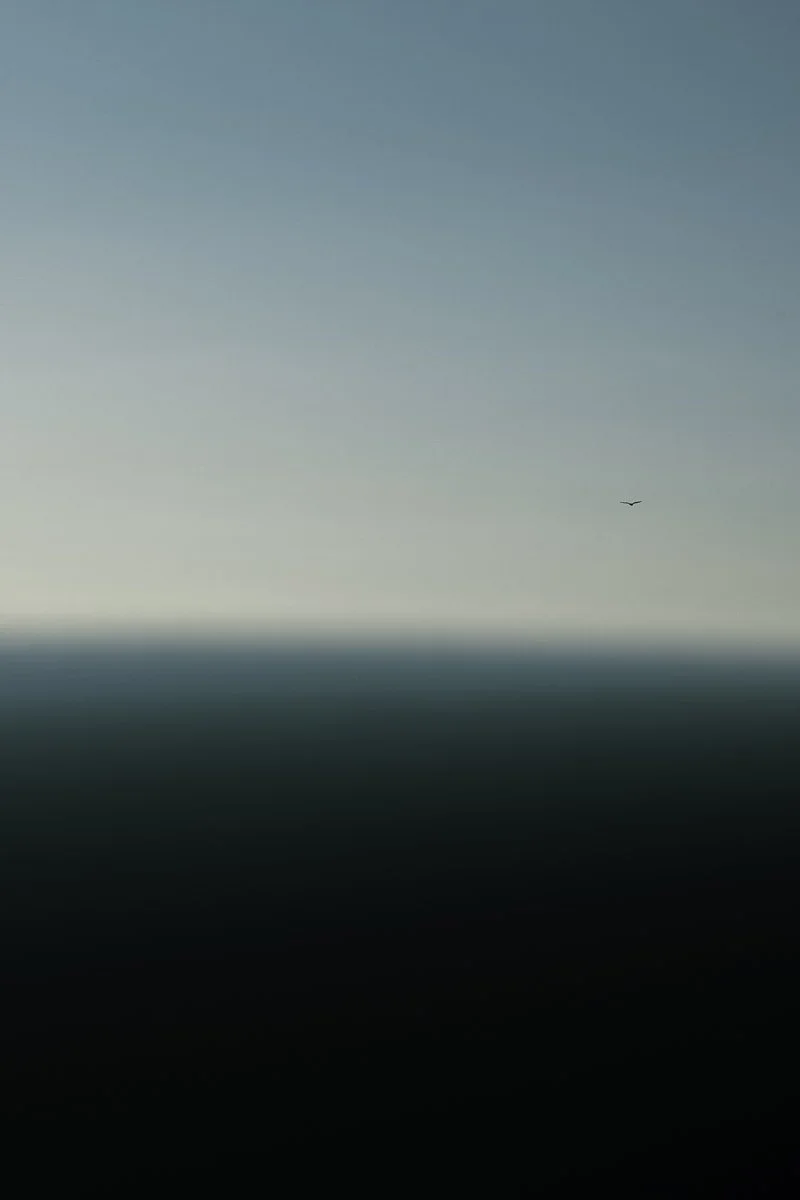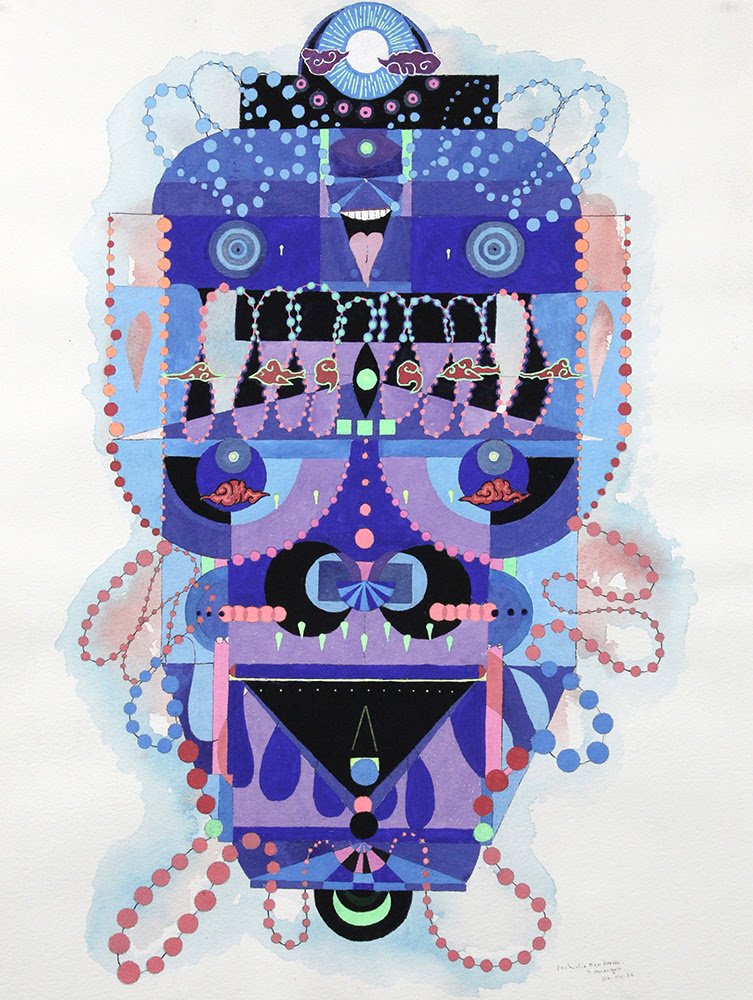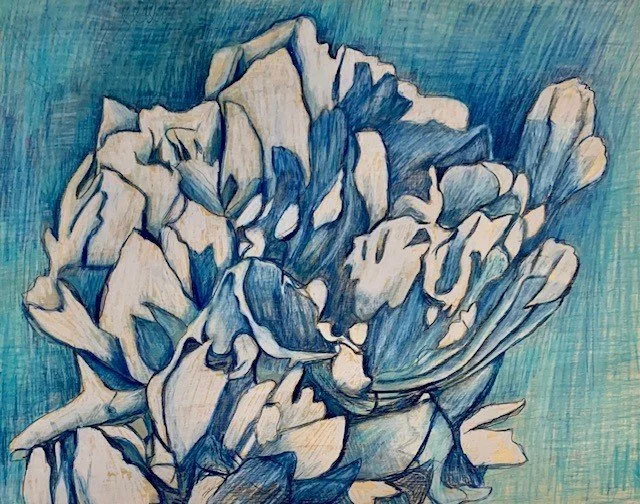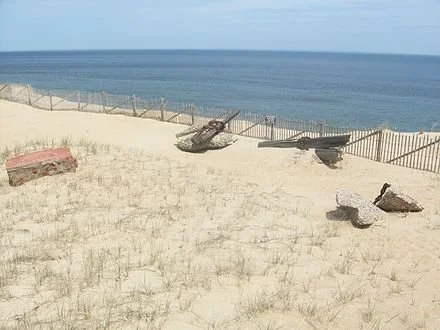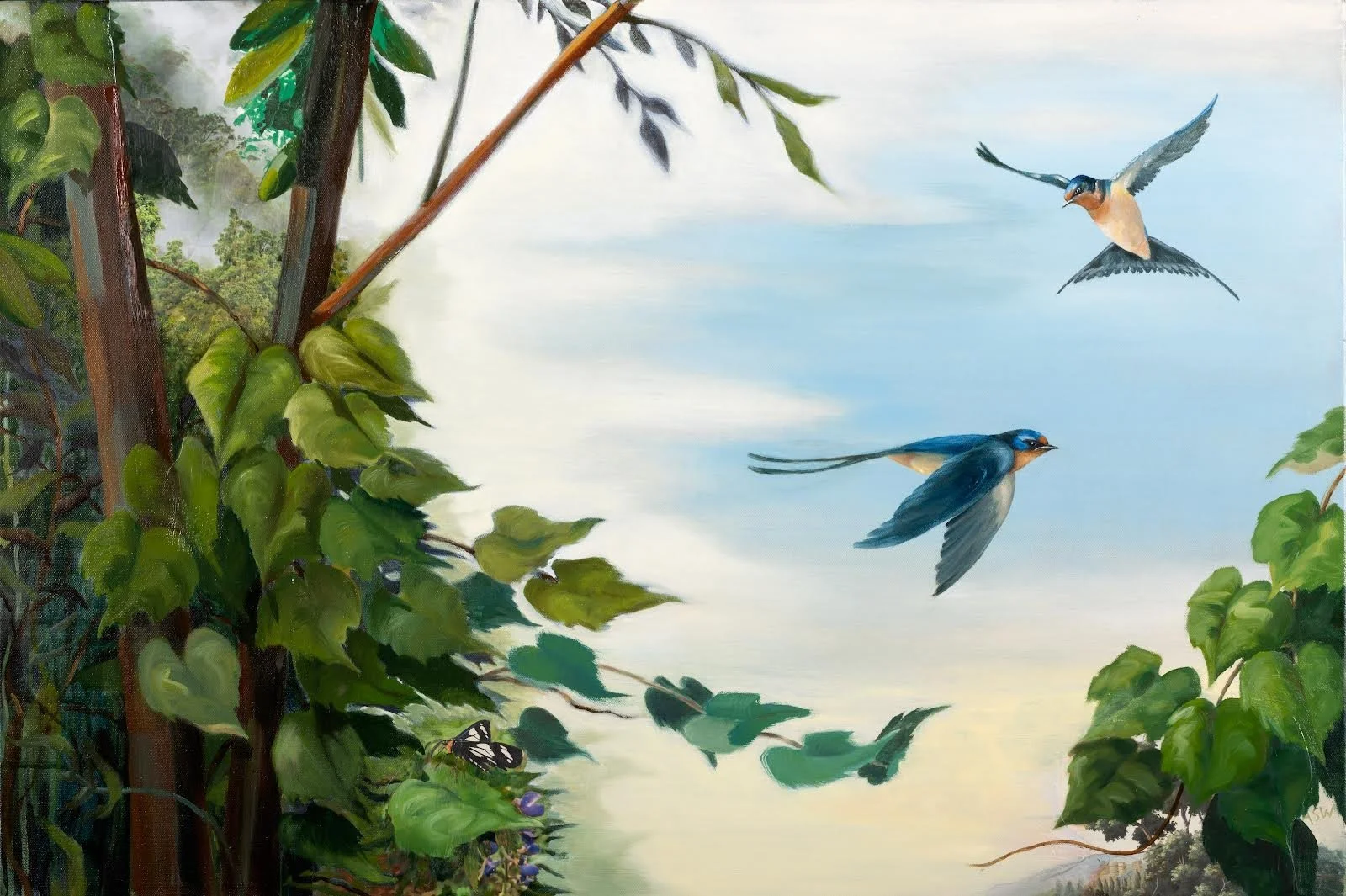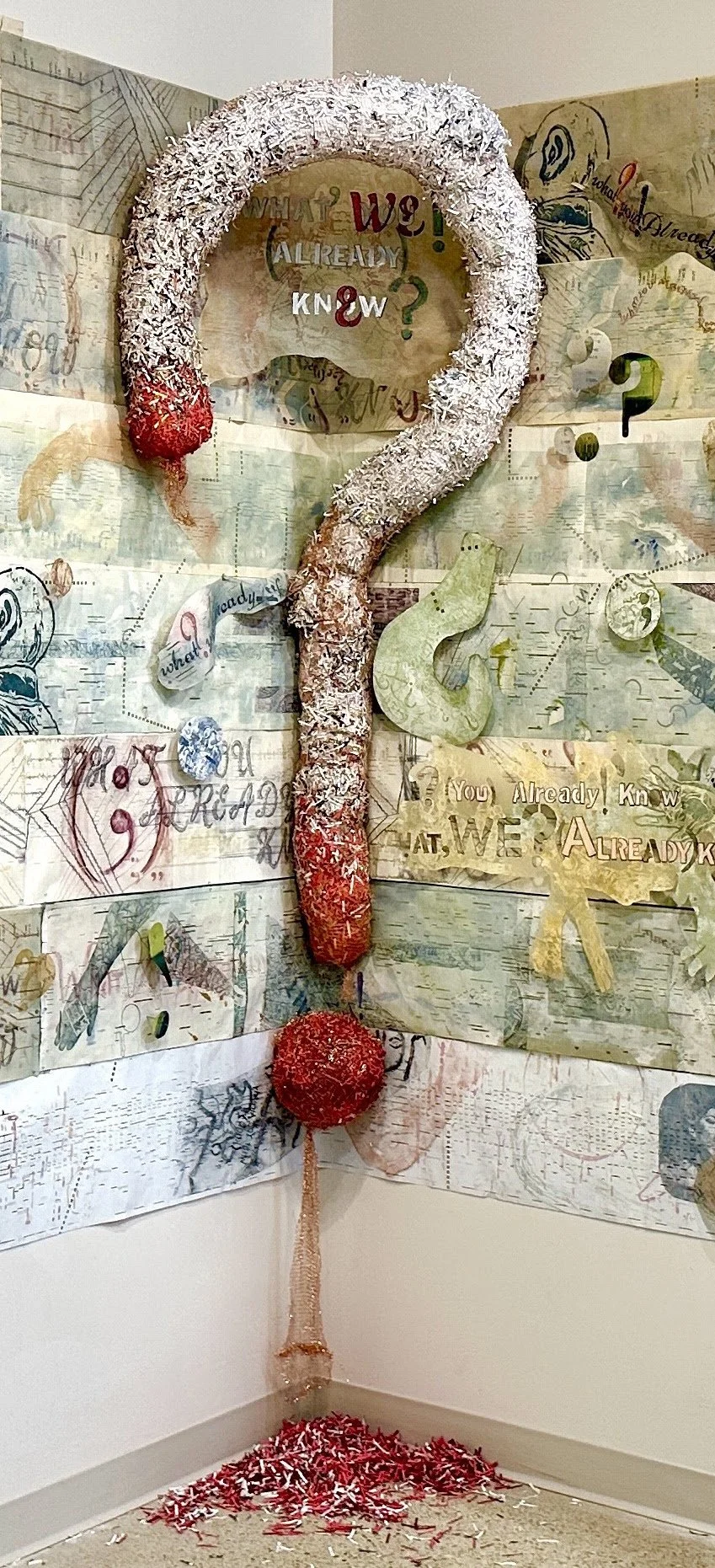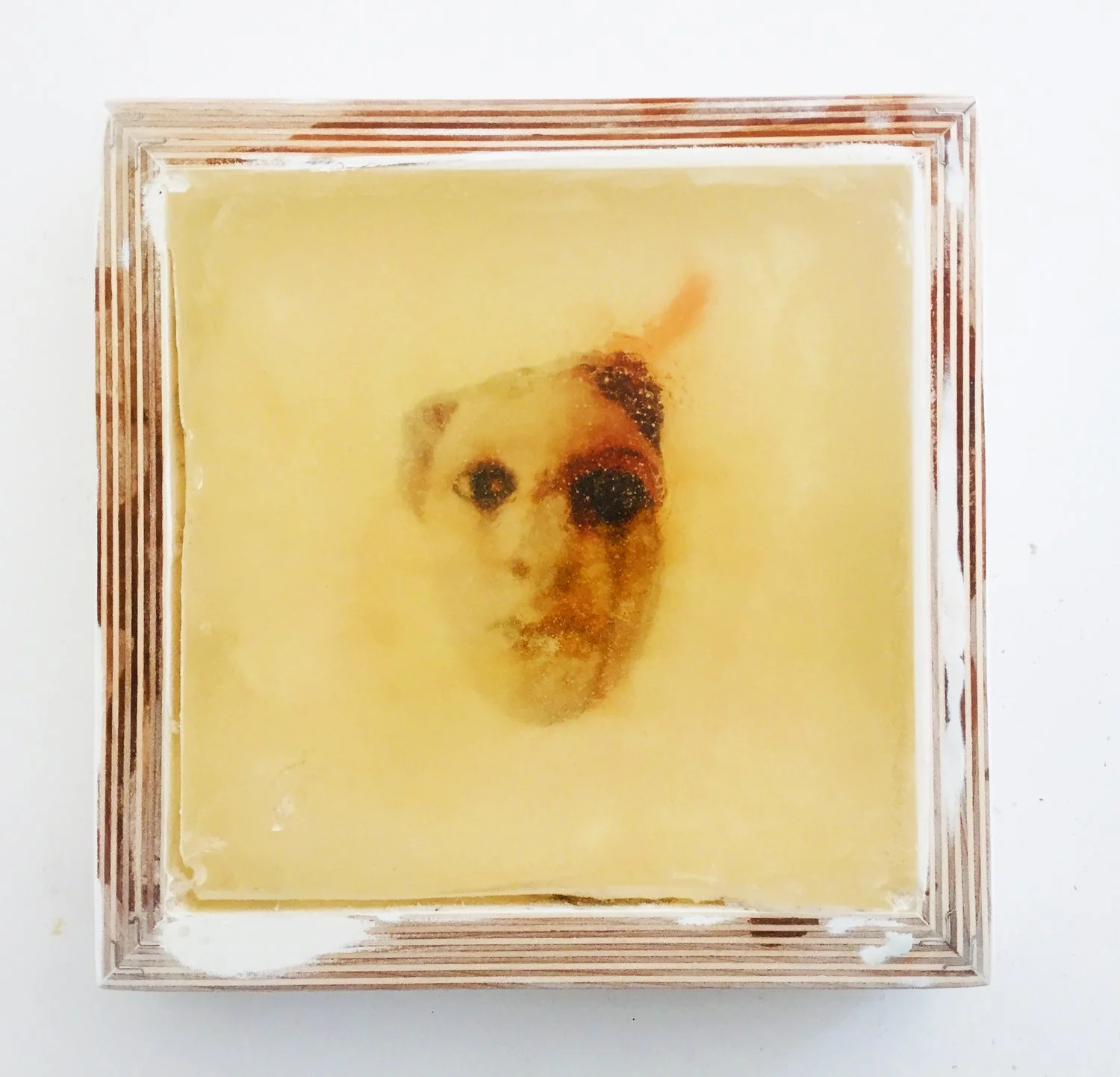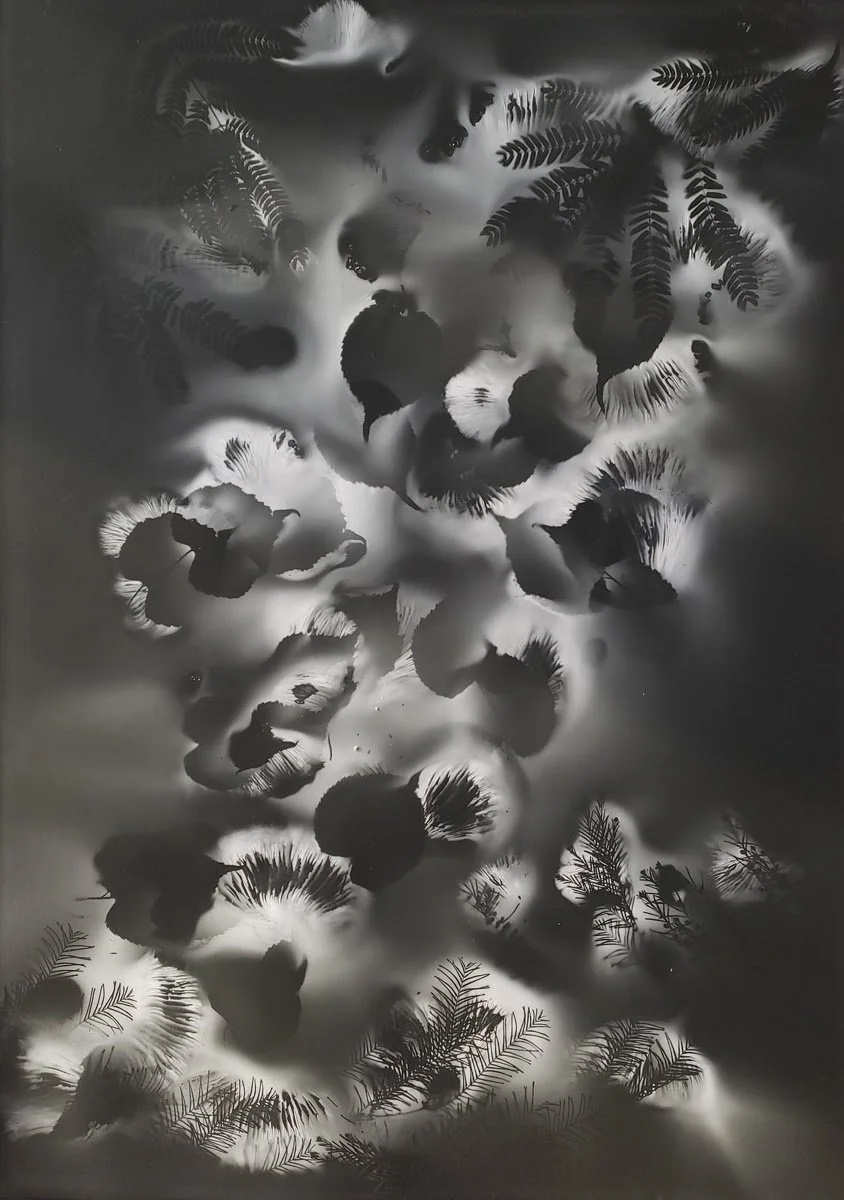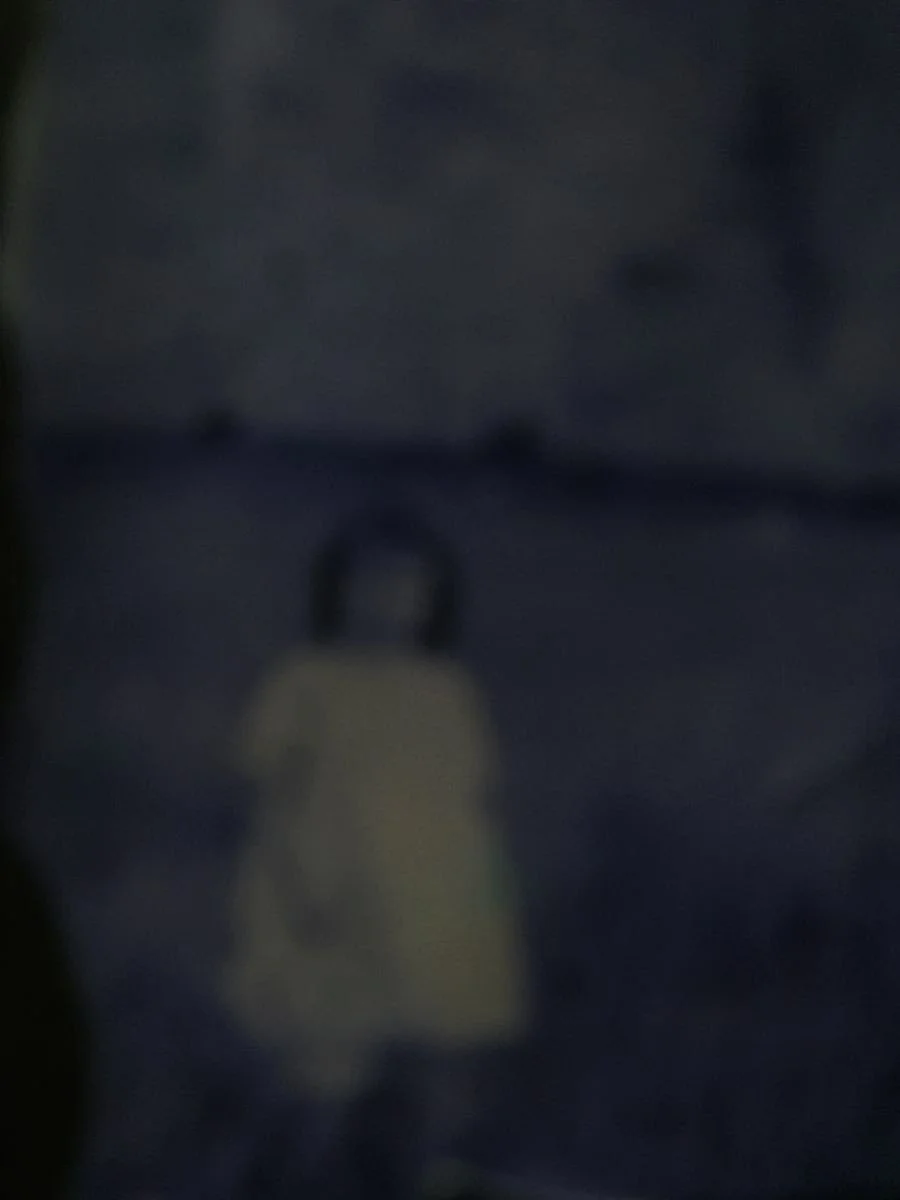
The color of longing
Untitled digital image by Diego Navarro, in the group show “The Blue of Distance,’’ at Kingston Gallery, Boston Jan. 2-Feb 1.
The gallery says:
This group exhibition is in response to the essay, “The Blue of Distance,” by Rebecca Solnit:
"For many years, I have been moved by the blue at the far edge of what can be seen, that color of horizons, of remote mountain ranges, of anything far away. The color of that distance is the color of an emotion, the color of solitude and of desire, the color of there seen from here, the color of where you are not. And the color of where you can never go. For the blue is not in the place those miles away at the horizon, but in the atmospheric distance between you and the mountains. ‘Longing,' says the poet Robert Hass, ‘because desire is full of endless distances.' Blue is the color of longing for the distances you never arrive in, for the blue world."
We’re all entangled
“Hassocky Meadow Trail, Ipswich River Wildlife Sanctuary,’’ in spring 2024, in Mary Lang’s show “Entangled,’’ at Kingston Gallery, Boston, through Nov. 2
She says:
“For decades my photographs had offered a feeling of space, often of groundlessness, of vast sky or open water, or at least an expansive horizon. Now, I am drawn to photograph tangled trees, vines, almost impenetrable thickets of growth. Why? What am I looking at? What am I trying to see? Or describe? This exhibition is the beginning of my answer to that question.
“First, these images are an invitation to take in complexity, to not feel claustrophobic when confronted by layers of growth, of living things, of pathless thickets, of entangled vines and branches. They are an invitation to be awed and drawn to more detail than your mind can absorb. In this fraught world, we need to increase our capacity to handle complexity. Secondly, they are a metaphor for entanglement, a term ecologists and climate activists use to describe the complexity of modernity: everything we do, everything that all of us do, everything that the earth does, is completely entangled, interdependent, inseparable. As human beings living in the Anthropocene era, we can’t avoid our complicity in the harm to the planet.’’
John Whipple House, in Ipswich, was built in 1677.
‘Fluttering meaning’
“Pachinko Mon Amour 3’’ (acrylic and watercolor), by Steven Bogart, in his show “Pachinko Mon Amour and other inventions,’’ at Kingston Gallery, Boston, Nov. 6-30.
The gallery says:
“The show’s vibrant, surreal paintings fuse humor, abstraction, and satire, drawing inspiration from the kinetic energy of pinball, with their bright lights, rhythmic sounds, and unpredictable movements, and Japanese Pachinko to probe humanity’s fascination with distraction and play. In these new works Bogart playfully explores the tension between organic geometry and imagined perspectives.’’
He says:
“I invite viewers into spaces where meaning flutters like a shimmering, ricocheting pinball, serving as a foil to the rigid architectures of logic.’’
As time speeds up
“Marking Time” (intaglio, relief collage, drawing on player piano scroll), by Randy Garber, in the show “So Late So Soon’’ at Kingston Gallery, Boston, through Sept. 28.
The gallery explains:
“‘So Late So Soon’ is a collaboration and dialogue between mother and daughter artists Randy Garber and Rachel Garber Cole. The work explores the concept of time: how it speeds up and lengthens, how the climate crisis catapults us simultaneously into the future and into our geological past. As humanity sits at the edge of our own geological era (the Holocene), and as our planet warms rapidly to a world unrecognizable to 10,000 years of human consciousness, the artists ask: How do we weave the passage of time (and timescale) into the fabric of our daily lives? How do we attend to the micro when the macro is shifting around us in unexpected ways?’’
Marvel at salt marshes
“Messages from the Marsh’’ (Part 5, video still 10, archival exhibition pigment print (Platine)), by Amy Kaczur in her joint show “The Great Muse —Three Artists Working With the Great Muse,’’ at Kingston Gallery, Boston, through July 27.
The gallery says that the show, with Kaczur, Resa Blatman and Max Schenk, is either “inspired by or touches on the beauty and ecological significance of salt marshes.’’
‘Porous boundaries’
From Linda Leslie Brown’s show “Circulations,’’ at Kingston Gallery, Boston, through April 27.
The gallery says:
“{Boston-based} Linda Leslie Brown’s sculptures explore the transformative exchanges between nature, objects, and the viewer’s creative perception. Her works are rich with allusions to the body, while simultaneously evoking a new, transgenic nature—one where corporeal and mechanical entities merge and recombine. The sculptures suggest a world that is both fluid and uncertain, where the boundaries between organic and synthetic are porous and ever-shifting.’’
Carpet of life
From “Messages from the Marsh—parts 4-6’’(video still), by Amy Kaczur, at Kingston Gallery, Boston, through Dec. 1.
‘Comfort without answers’
“Here Yet,’’ by Lynda Schlosberg, in her show “Somewhere in Between,’ at Kingston Gallery, Boston, through Sept. 29.
The gallery says:
“The paintings in ‘Somewhere in Between’ span the last three years of an ever-shifting existence. Floating in a state of limbo somewhere between life and death, between here and there, between then and now and what is yet to be. Traversing wandering threads of individual and connected lives as they pass through time and space. Exploring uncertainty of the unknown and seeking comfort without answers.’’
‘Metaphor for life’
“Towards a Blue Planet” (color pencil on wood), by Massachusetts artist Stacey Cusher, in the group show “Everything Leaves a Mark,’’ at Kingston Gallery, Boston, April 3-28.
She says in her artist statement:
“Trees, forests and flowers are iconic and an endless source of inspiration. In drawing these, I locate different textures and emphasize the shapes of trees and differing values in graphite or blue color pencil to speak to their sturdiness and the capacity to withstand these times. They’re a metaphor for life. We have a constant relationship with them. As Sara Maitland, author of From The Forest, describes, “[r]ight from the beginning, the relationship between people and forest [and flora] was not primarily antagonistic and competitive, but symbiotic.”
“And from the slow process of creating drawings, floral paintings and animal portraits found in these gardens, forests and in unexpected places, a meditative presence occurs. There is a grandeur in nature and a spirit. Creating scenic worlds, even in still life paintings, segue into wonder, daydreaming, and contemplation. A child-like feeling occurs when anything seems possible: infinite immensity and infinite possibilities.’’
‘As Covid morphed’
“Lavender Light,’’ by Phyllis Ewen, in her show “My Mind’s Eye,’’ at Kingston Gallery, Boston, March 1-March 31. She lives in Somerville and Wellfleet, Mass.
She says:
“As Covid-19 continued and morphed, my art turned inward. A new series of lithographs reflected my changing state of mind and is continuing as is the pandemic. These lithographs come from MRI images of a brain.’’
“Guglielmo Marconi built the first transatlantic radio transmitter station on a bluff in South Wellfleet in 1901–1902. The first radio telegraph transmission from the United States to England was sent from this station on Jan. 18, 1903, a ceremonial telegram from President Theodore Roosevelt to King Edward VII. Most of the transmitter site is gone, however, as three quarters of the land it originally encompassed has been eroded into the sea. The South Wellfleet station's first call sign was "CC" for Cape Cod.’’
— Edited version of a Wikipedia entry
The ‘meaning of weight’
From Massachusetts-based arist Kledia Spiro’s show “Drawing in Air,’’ at Kingston Gallery, Boston, through Jan. 28.
The gallery says:
“Kledia Spiro’s solo exhibition ‘Drawing in Air’ delves into the fascinating interplay of weight, legacy, and the human experience.
”Over the last decade, {Albanian-born} Spiro has embarked on a quest to understand the meaning of ‘weight’ in people's lives. Spiro's project blurs the lines between information design and art, using drawings to create data for music production. In the gallery, Spiro will physically paint signature light drawings in mid-air. Spiro has collaborated with two diverse musicians, Lianna Sylvan and Kevin Baldwin, to translate her light drawings into a captivating music composition. Using sensors placed throughout the exhibition, each drawing triggers a unique sound experience for the visitor.’’
There’s a use for everything
“What Remains’’ (mixed media)., by Massachusetts-based artist and fencing coach Elif Soyer, in her show “Making Meaning,’’ at Kingston Gallery, Boston, Nov. 29-Dec. 30.
"Everyday takes figuring out all over again how to f***ing live.”
(Calamity Jane/Deadwood)
The gallery says:
“‘Making Meaning’’’ is a conglomeration of old and new ideas and experiments, culminating in fabrications, layered with both time and materials. For Soyer, the Calamity Jane quote from her favorite character and all time favorite show is true for most of us. Soyer ponders this existential question often, especially in the studio where, for her, making art is making meaning out of the mundane, through work and invested time. Oscillating between the interior landscape of the human body and the exterior landscape of her immediate environment, through collecting, layering or other seemingly obsessive processes, Soyer’s work has always had a very strong tie to time.’’
Our ‘precarious place’
“In the Wind ‘‘ (oil, acrylic and collage on stretched canvas), by Anne Sargent Walker, in her show “Out on a Limb,’’ at Kingston Gallery, Boston, Oct. 4-29
She says:
“My mixed media paintings explore the beauty, complexity and fragility of the natural world and our complicated relationship with it. The surface content of birds, flora and other creatures often degrades, peels back, dissolves or drips to reveal layers underneath, suggesting the planet’s warming, loss of habitat, species, the earth itself and of course us.
‘‘‘Out on a Limb’ refers to the precarious place we have arrived at. Mass extinction of species is at hand. Invasive species threaten our landscapes, A warming climate is making habitat for both humans and animals unlivable. There is good news too, but we must make changes now.’’
‘Visual equivalents’
“Scrip(t) Scraps, Version 1’’ (intaglio, relief prints on player piano scrolls with 5.5’ etched copper parentheses, copper mesh stuffed with shredded paper), by Somerville, Mass.-based artist Randy Garber, in her show “Scrip(t) Scraps,’’ at Kingston Gallery, Boston, Nov. 1-20.
She says:
‘“My work investigates perception and how meaning is deciphered. I have consistently—and persistently—focused on finding ways to visually express both the beauty and vagaries of communication. Profoundly hard of hearing since infancy and acutely aware of the potential for misinterpretation, I explore the spaces between silence and sound: confusion and clarity, chaos and precision.
“Interested in gaps between our five (known) senses and how they inform, influence and intercept one another, I aim to find visual equivalents that suggest the complicated processes in how we receive and make sense of information. I create structures and images that evoke, for instance, cochlea, ear drums, instruments, neural networks and language systems.’’
'Better Homes Than Gardens'
”Thank Your Lucky Stars’’ (custom view-master you with reel), by Krystal Brown, in her show “Better Homes Than Gardens,’’ at Kingston Gallery, Boston, Aug. 30-Oct 1.
The gallery explains:
That the show “confronts the current national housing crisis and the widening wealth gap head on through the lens of autobiography, asking the viewers to grapple with their complicity in the current situation, while laying bare Brown’s family’s struggles with poverty and housing in Boston during their childhood.’’
Beauty from the struggle
"To Slip Away Without a Sound” (dye sub aluminum), by Vaughn Sills, in her show “Joy and Sorrow Intertwined,’’ at Kingston Gallery, Boston, Oct. 4-Oct. 29.
The gallery says:
“Vaughn Sills’s compelling photographs create a stage for both the growth and decay, the birth and death, in nature. Her … compositions draw us into a timeless narrative, a metaphor for the struggles of human existence and our failing environment.’’
She is based in Cambridge, Mass., and Prince Edward Island.
Stare from the deep past
“Athenian fragment of a face,’’ (archival pigment print, oil, resin, wood ), by Boston-based artist Jennifer Liston Munson, in her show “Looking In + Looking Out,’’ at Kingston Gallery, Boston, July 5-July 30.
Her artist’s statement includes:
“Jennifer Liston Munson’s work for her show …. creates lenses for the viewer to look in and for the subjects themselves to look back out. Her selection of art objects, ghostly figures, and landscapes call into question historical collection practices, the complexity of narratives, and the notion of belonging. ‘Looking In + Looking Out’ incorporates images of objects held in museum collections, photographs of unknown relatives, and abandoned historically significant interiors. In some of the pieces, Liston Munson makes the landscape the subject; spaces, trees, and enigmatic watery pools that remain while the bodies they contain dissolve to time, as layers of paint ooze from the edges to mark the art making process and the past. Other works look at architecture and history close up, making the past present.’’
#Kingston Gallery
Maybe don’t go any further
Photo by Massachusetts-based artist Chantal Zakari, in her show “Chantal Zakari: New Works,’’ at Kingston Gallery, Boston, Aug. 30-Oct. 1
She says:
“I am inspired by social phenomena and position myself in relation to the public. I freely combine research methodologies and artistic strategies from various disciplines such as photography, documentary, graphic design, performance, storytelling, installation, and social interventions. Text and language are an inherent part of my work; interviews, personal narrative, found text, all have the potential to contextualize the imagery. My work is project based. As I explore projects over the span of several years, the work can transform into exhibitions, installations, publications, performances and street happenings. Designing and redesigning the work into different contexts brings me a greater understanding of the ideas, and makes it more accessible to different groups of audiences.”
The mysteries of gray/grey
“Upward” (mushroom spores on paper), by western Massachusetts-based artist Madge Evers, in the group show “Grey Areas,’’ at Kingston Gallery, Boston, Aug. 2-27
The gallery says:
This year’s annual exhibition by Kingston Gallery’s Associate Artists explores the theme of “Grey Areas’’ from different perspectives and media. …The 10 artists interpret our world with divergent approaches to both the enigmatic concept and the color grey….They explore liminal places, ideas, and eras that generate questions - many without answers. Responding to the existential areas of an unknowable future or the space between ecosystems, they wonder how to acknowledge non-human collaborators, the myriad ‘what-ifs’ of depression, and the question of secrecy and abuses in institutions and systems of government that operate in obscurity. The diversity of work plays with grey’s ability to take on hue and enliven color, consider the spin of the stories we tell, uncertainty in understanding our world, and the difficulty of truly knowing the space one occupies in that world.’’
xxx
“Madge Evers has adapted the spore print, a mushroom identification tool typically used by mycologists and foragers, to create biomorphic monochromatic works on paper. Like the wind and other animals, she spreads the spores of mushrooms; germinates their powdery spores as they land on paper and creates her version of a fruiting body - it forms a two-dimensional image rather than toadstool. In this interdependence with mushrooms, she wonders: How do I best acknowledge my unwitting collaborators?’’
View from Mount Holyoke, Northampton, Mass., after a thunderstorm—The Oxbow (of the Connecticut River) (1836), by Thomas Cole
We all feel the ‘presence of absence’
“Presence of Absence: Looking In + Looking Out #1” (pigment print, lucite oil and wood), by Boston-based artist Jennifer Liston Munson, in her show “Presence of Absence,’’ at Kingston Gallery, Boston, July 4-July 30
The gallery says:
”Ghostly figures in found photographs of unnamed relatives from Jennifer Liston Munson’s unknown past occupy a landscape of inherited memory. Photographs are buried in resin, holding the figures in time and space, allowing them to look out as we look in. Liston Munson asks the viewer to linger on these elegiac images as an act of resurrection, to substantiate the precariousness of personal histories and the delicate process of perception.
“In some of the pieces, Liston Munson makes the landscape the subject; spaces, trees, and enigmatic watery pools that remain while the bodies they contain dissolve to time, as layers of paint ooze from the edges to mark the art-making process and the past. Other works look at architecture and history close up, making the past present. A series from an interior room of the Alcazar in Toledo, Spain captures bullet holes in worn wallpaper caught in the crossfire of the Spanish Civil War. New sculptural towers layer colorized resin blocks that obscure buried images of objects normally held in museum vitrines, detached from their cultures of origin for eternity.’’
